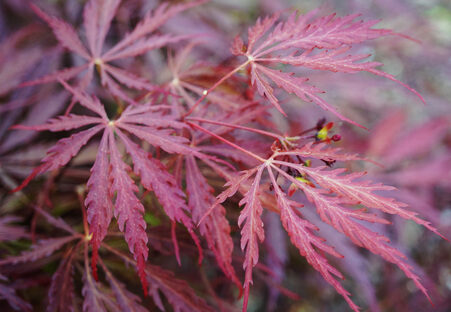
We just received a shipment of stunning Japanese Maples! Check out our selections below to find your new favorite tree. All listed varieties and sizes are available as of 4.15.2022, but these plants won’t last long. Shop soon for the best selection.
Tallahassee Nurseries is very happy to offer our Japanese Maples in a variety of sizes and prices. We know these slow-growing trees are some of the more expensive plants we carry and we want to make them accessible to everyone. Whether you want one baby tree in a pot, or a whole forest of maples, Tallahassee Nurseries has the quality, selection and service to help you get started growing Japanese Maples.
(Full Gallery & Care Instructions Below)
Bloodgood 2g, 7g
This is Tallahassee’s favorite red Japanese Maple! The super-strong trees produce lush burgundy red leaves that hold their color from spring through fall.
Glowing Embers 7g
Superior selection with excellent heat tolerance. Leaves have red purple orange fall color that glow like embers. One of our most spectacular fall color trees! Moderate grower to 15′-20′ tall with equal spread. Deciduous. Perfect character for a small yard or patio area. Can take full sun, but also does well in partial shade.
Coral Bark (Sango Kaku) 3g, 7g
Young branches & stems sport a bright red color for their first few years. Vigorous plants retain a delicate appearance with light green leaves. Reliable, golden-yellow fall color!
Waterfall 3g
Layers of delicate, bright green leaves cascade to the ground like a mossy waterfall flowing over ancient boulders. Lovely yellow fall color.
Orange Flame 3g, 7g, 10g
A kaleidoscope of color: new leaves emerge orange, then turn light green, the second flush of growth in late spring emerges bright orange, & the fall color is a mix of orange, red & yellow!
Orido Nishiki 3g, 10g
A rare, variegated variety, the green leaves emerge covered in bold splashes of pink & white color. Fall color is red to maroon. An unusually strong grower for a variegated tree.
Emperor One 1g, 2g, 5g, 7g
Produces crimson red leaves that hold their color from spring-fall in sunny locations. Lovely near the house. Another bulletproof Japanese Maple that can be planted in full sun!
Red Dragon 2g, 5g
Red Dragon has been called the ultimate laceleaf. The spring color is Christmas-red fading back to deep purple red. Turns crimson red in fall. Reported to have high heat tolerance. Best if planted in filtered sun with good drainage. Moderate grower to 10 feet tall and wide.
Tamukeyama 3g
Beautiful, weeping branches are like living sculpture in a container or in the garden. Leaves are brilliant red in spring and fall.
Crimson Queen 2g
Low-branching, dwarf tree with delicate weeping effect. Holds beautiful crimson color in spring and fall before dropping. Well-suited for use as a small lawn tree or on patios and entryways. Best if planted in filtered sun with good drainage. Moderate grower to 10 feet tall and wide. There is a mature specimen of this variety planted in the ground at Tallahassee Nurseries.
Collectors’ Maples 10g, 20g
A diverse collection of rare and hard-to-find Japanese Maples that have been expertly grown by one of our specialty suppliers. These varieties are in very limited quantities, we have only 1 of quite a few of them. These are for the serious collector or Maple aficionado. The stock of these gorgeous trees changes quickly, we ask all interested parties to come to the nursery to explore them in person.
Japanese Maple Care
Area:
Japanese Maples are able to grow over a very wide geographical range, covering almost every bit of the continental United States. North Florida, however, is pushing the southern extreme of that range. Of the thousands of Japanese Maple varieties that exist, only a small fraction of them will be happy to live in our hot humid climate. Tallahassee Nurseries is sure to stock the most heat tolerant varieties for you to choose from, but proper care is critical to help these stunning trees look their best.
Sun Needs:
Most Japanese Maples cannot handle being planted in full sun in Tallahassee. Most Japanese Maples should be planted where they receive direct sun in the morning, but get shade in the hot afternoon. Japanese Maples also thrive in filtered or dapple light all day, like that found under mature oak trees or pines.
Some direct sun is required to produce good leaf color throughout the growing season. Avoid planting Japanese Maples in full or deep shade. They will survive in deep shade but their color will be greatly diminished. Try to find a spot in your yard that gets the most sun possible from dawn until 1pm or 2pm. Most Japanese Maples definitely want shade in the afternoon or the leaves may be damaged.
There are a few exceptions to the rule. Some Japanese Maples can even tolerate full sun in Tallahassee. Bloodgood and Emperor One (both red leaf), as well as Glowing Embers and Coral Bark (both green leaf) are all able to thrive in the sunniest of locations in North Florida…IF, you give them the proper care.
Soil, Mulching & Watering
Japanese Maples are best planted on low mounds of soil to ensure good drainage around their roots. Create a smooth, gentle mound of soil 3’-6’ wide and 1’-1.5’ tall in the center. This raised mound of soil will drain excess water to create just the right conditions for Japanese Maples. Gardeners should also apply and maintain a thick layer of mulch around their Japanese Maples. Any natural material is fine (pine straw, pine bark, wood chips, leaves, compost). These materials will help keep the roots cool and moist. Try to keep a 4 inch deep layer of mulch. Most people do not apply enough mulch to get the maximum benefits. Pull the mulch a few inches away from the base of the trunk to keep the trunk healthy.
Overheating roots are the primary cause of problems for Japanese Maples in our climate. Mulch and frequent waterings in hot weather are the best way to cool the soil and roots. Mulch insulates the soil, protecting it from the sun’s heat, while the planting mound offers maximum drainage so you can water as often as needed without fear of creating soggy soil.
Expectations for New Japanese Maples
We all want results fast (myself included), but gardening in general, and Japanese Maples specifically are a slow game. You must have patience with new Japanese Maples. This group of small trees is exceptionally strong, resilient, and long-lived, but they need time to acclimate to new environments. If you give them the basic care and time they need to become established they will can become the showpiece of your landscape.
Expect to see transplant shock from any Japanese Maple planted in spring or summer. Moving from a container in the nursery to a new home, with new conditions, and new care can be traumatic for Japanese Maples. Expect to see leaves wilting and some may even develop brown or gray edges. The key is water. Do not let new maples dry out at all. They need that cool water to help fight the heat.
Many Japanese Maples look a little rough for their entire first year in the ground. But, with proper planting and care they almost always return in full glory for their second year, and many get prettier and stronger every year thereafter. Planting in fall or winter will dramatically reduce transplant shock. Japanese Maples are deciduous (they lose their leaves each winter), which makes them very easy to transplant or move in the winter while they are sleeping. All Japanese Maples would be planted in fall or winter ideally, but those that are moving into a sunny location benefit the most from dormant season planting. Try to look ahead to your spring garden and plant any desired Japanese Maples in the fall or winter.
If you find the right spot, plant on a mound, mulch deep and wide, and keep them well watered you can expect to grow happy and healthy Japanese Maples in the real deep south.
*This article was written by Jonathan Burns (Tallahassee Nurseries Outdoor Manager, FNGLA Florida Certified Horticulture Professional) using years of personal observations growing in the Tallahassee area.

